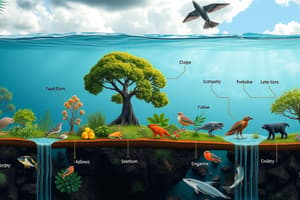Podcast
Questions and Answers
Explain the concept of trophic levels in a food chain and provide examples of organisms found at each level.
Explain the concept of trophic levels in a food chain and provide examples of organisms found at each level.
Trophic levels in a food chain refer to the different levels at which organisms obtain their energy by consuming other organisms. The first trophic level consists of autotrophs or producers, such as plants or algae. The second trophic level consists of herbivores or primary consumers, such as grasshoppers or rabbits. The third trophic level consists of carnivores or secondary consumers, such as snakes or frogs. The fourth trophic level consists of top carnivores or tertiary consumers, such as hawks or eagles.
What are autotrophs or producers, and how do they obtain their energy?
What are autotrophs or producers, and how do they obtain their energy?
Autotrophs or producers are organisms that can produce their own food through photosynthesis or chemosynthesis. They obtain their energy by converting sunlight or inorganic compounds into organic molecules.
Define herbivores or primary consumers and provide examples of such organisms.
Define herbivores or primary consumers and provide examples of such organisms.
Herbivores or primary consumers are organisms that consume producers. Examples of herbivores include grasshoppers, rabbits, and deer.
Explain the role of carnivores or secondary consumers in a food chain and provide examples of organisms at this trophic level.
Explain the role of carnivores or secondary consumers in a food chain and provide examples of organisms at this trophic level.
What are top carnivores or tertiary consumers, and how do they contribute to the ecosystem?
What are top carnivores or tertiary consumers, and how do they contribute to the ecosystem?
Flashcards
Trophic Levels
Trophic Levels
Levels in a food chain showing how organisms get energy.
Autotrophs/Producers
Autotrophs/Producers
Organisms that make their own food using sunlight or chemicals.
Herbivores/Primary Consumers
Herbivores/Primary Consumers
Organisms that eat only plants (producers).
Carnivores/Secondary Consumers
Carnivores/Secondary Consumers
Signup and view all the flashcards
Top Carnivores/Tertiary Consumers
Top Carnivores/Tertiary Consumers
Signup and view all the flashcards
Study Notes
Trophic Levels in a Food Chain
- A food chain consists of multiple trophic levels, each representing a level of energy transfer from one organism to another.
- Energy flows from one trophic level to the next, with each level representing a different feeding position in the ecosystem.
Autotrophs or Producers
- Autotrophs are organisms that produce their own energy through photosynthesis or chemosynthesis.
- Examples of autotrophs include plants, algae, and some bacteria.
- Autotrophs obtain their energy from sunlight, carbon dioxide, and water.
Herbivores or Primary Consumers
- Herbivores are organisms that consume autotrophs as their source of energy.
- Examples of herbivores include rabbits, deer, and caterpillars.
- Herbivores obtain their energy by consuming plants and other autotrophs.
Carnivores or Secondary Consumers
- Carnivores are organisms that consume herbivores as their source of energy.
- Examples of carnivores include frogs, birds, and small fish.
- Carnivores obtain their energy by consuming herbivores, which have already obtained energy from autotrophs.
Top Carnivores or Tertiary Consumers
- Top carnivores are organisms that consume carnivores as their source of energy.
- Examples of top carnivores include lions, sharks, and bears.
- Top carnivores contribute to the ecosystem by regulating the populations of carnivores and herbivores, maintaining the balance of energy flow in the ecosystem.
Studying That Suits You
Use AI to generate personalized quizzes and flashcards to suit your learning preferences.




